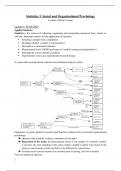College aantekeningen
Uitgebreide Aantekeningen Statistiek 3, Social and Organizational Psychology Track
- Vak
- Instelling
Uitgebreide college aantekeningen van het vak Statistiek 3, Social and Organizational Psychology track in het Engels geschreven. Er wordt gebruik gemaakt van voorbeelden en afbeeldingen om de tekst/begrippen duidelijker te maken.
[Meer zien]












